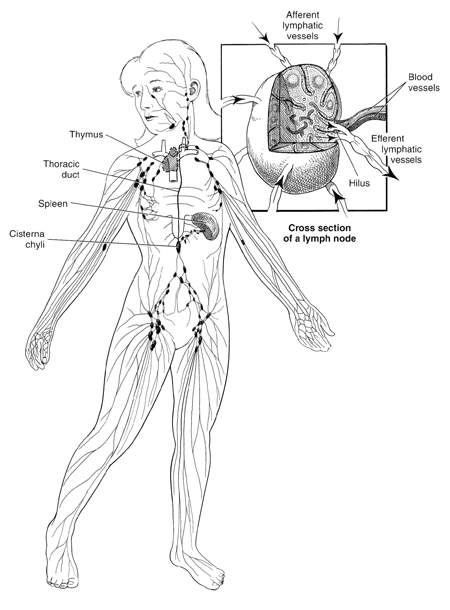Lymphoma
Can I Get Social Security Disability Benefits for Lymphoma?
- About Lymphoma and Disability
- How to Get Disability Benefits for Lymphoma by Meeting a Listing
- Residual Functional Capacity Assessment for Lymphoma
- Getting Your Doctor’s Medical Opinion About What You Can Still Do
If you have lymphoma, Social Security disability benefits may be available. To determine whether you are disabled by your lymphoma, the Social Security Administration first considers whether it is severe enough to meet or equal a listing at Step 3 of the Sequential Evaluation Process. See How to Get Disability Benefits for Lymphoma by Meeting a Listing. If you meet or equal a listing because of your lymphoma, you are considered disabled. If your lymphoma is not severe enough to equal or meet a listing, the Social Security Administration must assess your residual functional capacity (RFC) (the work you can still do, despite the lymphoma), to determine whether you qualify for disability benefits at Step 4 and Step 5 of the Sequential Evaluation Process.
About Lymphoma and Disability
Lymphoma is a type of neoplasm (tumor) which is malignant and involves the lymphatic tissue and spleen. The major types are Hodgkin’s disease and non-Hodgkin’s lymphoma. The latter types of lymphoma are more serious. In either instance, there are a variety of subtypes. Lymph nodes are nodules about the size of a pea found throughout the body and connected by the ducts of the lymphatic system. Lymph nodes produce lymphocytes and other cells which play a critical role in immunity. The lymphatic system serves as a pathway in spreading some forms of cancer, but in the case of lymphomas the cancer starts in the lymph nodes themselves. Weakness, fatigue, and malaise are characteristic symptoms of lymphoma but are non-specific. There may be no symptoms at the time of diagnosis; awareness of an enlarged lymph node such as in the neck may cause the patient to seek medical attention.
Lymphoma is not contagious. As lymphoma is generally a cancer responsive to treatment, the great majority of lymphoma claims do not have serious illness long enough to qualify for benefits. Many are asymptomatic after treatment. However, there are a few exceptions. Most other cancers are much more serious. See Residual Functional Capacity Assessment for Lymphoma.

Lymphatic System: Figure 5-12 (Medical Evidence by Quinn, Quinn, and Quinn)
Hodgkin’s Disease
In Hodgkin’s disease four different subtypes are lymphocyte predominance, mixed cellularity, nodular sclerosing, and lymphocyte depletion. Patients may present with enlarged lymph nodes, night sweats, fever, and weight loss. None of these findings may be present if the lymphoma is diagnosed early enough.
Hodgkin’s disease is staged in degrees of severity at the time of diagnosis, allowing determination of prognosis and planning of proper modes of treatment. Sometimes, exploratory abdominal surgery (laparotomy) is necessary for adequate staging. Stage I means the lymphoma is confined to one area of lymph nodes. Stage II means two or more lymph node regions on the same side of the diaphragm are involved, i.e., the same side of the body. Stage III means lymphoma on both sides of the diaphragm involving lymph nodes or spleen. Stage IV means there is involvement outside the lymph nodes, e.g., lungs, bone marrow, or liver. However, if the extra-nodal involvement is simply because it is adjacent to an involved lymph node, it is classified as Stage IIE rather than Stage IV. That is because the lymphoma is actually still locally confined. The letters “A” or “B” are added to distinguish whether the patient is asymptomatic or symptomatic, respectively. Symptoms and signs include fever, weight loss, and night sweats.
Treatment consists of chemotherapy (drugs) and/or radiation as appropriate to the individual case. About 90% or more of Stage I and II Hodgkin’s lymphoma cases can be cured; some studies report complete remission rates as high as 97-99%. That is why it is reliable to be confident that Stage I or II will not last 12 months, especially when some positive response to treatment has been obtained. No significant functional impairment will generally be present 12 months after treatment starts, so these early lymphomas rarely fulfill duration, despite the fact that considerable toxicity may be present during treatment—especially if radiotherapy is also given as well as chemotherapy. Even in Stage III Hodgkin’s disease, cure rates as high as 75 – 80% have been achieved. In Stage IV disease chemotherapy can produce a remission of disease in 70 – 80% of cases with at least half of these remaining without disease for as long as 10 years. While the SSA might be justified in projecting an excellent recovery from the treatment of Hodgkin’s lymphoma, especially for the early stages of the disease, some individuals experience persistent long-term fatigue despite complete objective remission and when present this fatigue should be considered in assessing residual functional capacity. See Residual Functional Capacity Assessment for Lymphoma.
Non-Hodgkin’s Lymphoma
Non-Hodgkin’s lymphoma (NHL) is more common in males. Symptoms and signs are similar to those for Hodgkin’s lymphoma. There are various subtypes which vary considerably in the prognosis for cure. Several staging classifications are in existence. Well-differentiated (low-grade) lymphomas are the least aggressive malignancies and so have a better prognosis. A poor prognosis exists for lymphoblastic T cell lymphoma, and peripheral T-cell lymphoma. NHL has usually spread widely by the time it is diagnosed. Stage I and II have much lower cure rates than Hodgkin’s disease, i.e., 50 – 60%. With newer drugs, similar cure rates have been achieved in some instances of Stage III and IV disease. Improvements are constantly being achieved in treatment of lymphomas, but most lymphoma allowances for disability fall into the non-Hodgkin’s category. There are many types of non-Hodgkin’s lymphoma. Even within a particular type of lymphoma, aggressiveness of the cancer can vary between individuals.
Continue to How to Get Disability Benefits for Lymphoma by Meeting a Listing.
